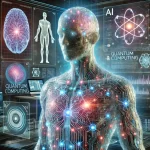
Novel Colon Cancer Biomarker Ku70 Unveils Potential to Deactivate Cancer Cells
February 1, 2024 Off By adminResearchers at the Australian National University (ANU) have identified a potential colon cancer biomarker, Ku70, which, when activated, acts as a surveillance system detecting signs of damaged DNA in cells. The activated state of the Ku70 protein may induce a dormant state in cancer cells. The researchers found that Ku70 can be manipulated or “turned on” by using a combination of new and existing drugs. The findings suggest the possibility of using Ku70 levels in precancerous polyps as a biomarker for predicting outcomes and screening for bowel cancer.
Key Points:
- Researchers at ANU have identified the protein Ku70 as a potential colon cancer biomarker with the ability to detect signs of damaged DNA in cells.
- The activated state of Ku70 acts as a surveillance system and may induce a dormant state in cancer cells.
- Ku70 can be manipulated or “turned on” using a combination of new and existing drugs, presenting a potential therapeutic approach.
- The study suggests the potential use of Ku70 levels in precancerous polyps as a biomarker for predicting outcomes and screening for bowel cancer.
- Early detection and treatment are emphasized as vital for overcoming bowel cancer and potentially other cancers.
- The findings highlight the significance of Ku70 as an immune biomarker, aiding in predicting patient outcomes after bowel cancer diagnosis.
Implications: The identification of Ku70 as a potential colon cancer biomarker and its ability to induce a dormant state in cancer cells offer promising avenues for research and clinical applications. The manipulation of Ku70 through drug combinations provides a potential therapeutic approach for controlling cancer progression. The potential use of Ku70 levels in precancerous polyps as a predictive biomarker emphasizes the importance of early detection and screening for bowel cancer. As research in this area progresses, Ku70 may play a crucial role in enhancing cancer prevention, detection, and treatment strategies, contributing to improved patient outcomes.
Reference
Pandey, A., Shen, C., Feng, S., Enosi Tuipulotu, D., Ngo, C., Liu, C., … & Man, S. M. (2024). Ku70 senses cytosolic DNA and assembles a tumor-suppressive signalosome. Science Advances, 10(4), eadh3409.
Table of Contents
ToggleRelated posts:
![Neanderthal-and-Denisovan]()
Neanderthals and Humans Coexisted 45,000 Years Ago: Genetic Revelations Rewrite History
news![Alzheimers-Disease]()
Predicting Alzheimer's Progression: A New Hope with Novel Learning Frameworks
news![The Future of Personalized Medicine and Genomic Medicine: A 20-Year Vision]()
The Future of Personalized Medicine and Genomic Medicine: A 20-Year Vision
news![blueberry]()
Unraveling Nature's Blue Secret: The Hidden Brilliance of Blueberries and Beyond
news![AI-coding]()
AI Coding Boom Raises Concerns Over Code Quality
news![quantumcomputing-AI]()
Today News: Artificial Intelligence (AI), Quantum Computing, and Robotics
A.I![What-Is-Synthetic-Biology]()
Scientists Unearth 188 New CRISPR Systems, Revolutionizing Gene Editing Possibilities
CRISPR![Researchers develop a robust technique for analysing massive patient datasets]()
Researchers develop a robust technique for analysing massive patient datasets
news![CRISPR-COVID-19]()
HIV Gene Editing: EBT-001 Clears SIV in Non-Human Primates, Paving the Way for Clinical Trials
news![Organicai]()
Organic AI: The Future of AI Inspired by Biology
A.I![COVID-19-SARS-CoV-2-deletedsequence.]()
Early COVID-19 symptoms vary by age group, according to new research.
news![obsessive_compulsive_disorder]()
Gene discovery could pave the way for more effective obsessive-compulsive disorder (OCD) treatments.
news![Exploring Ancient Partnership Between Moss and Fungi Unveils Intriguing Dynamics]()
Exploring Ancient Partnership Between Moss and Fungi Unveils Intriguing Dynamics
news![AI-maths-Chatgpt]()
The Future of Artificial Intelligence: A 20-Year Odyssey
A.I![Stargate-AI]()
The Stargate Project: A $500 Billion Leap into the Future of AI and Its Transformative Impact on Hea...
A.I![The Protein's Mark of Death: Decoding the Ubiquitin Code's Hidden Message]()
The Protein's Mark of Death: Decoding the Ubiquitin Code's Hidden Message
news


















